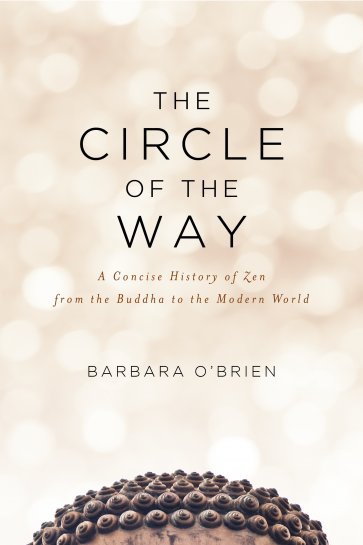
The Circle of the Way by Barbara O’Brien (Shambhala Publications) is an ambitious attempt to accomplish two key approaches in understanding Buddhist history. as our perspectives of Buddhism have broadened (and hopefully also deepen). First, the re-telling of Buddhist history is marked by a dropping off unexamined stories as we acknowledge and cope with its romanticization and impact of its appropriation by the West. Second, as we become more aware of the complex intersectionality of our inner and outer environments, aspects of Buddhist philosophy and practices that may not address the issues in our times are being deeply questioned.
Academic and popular press publications in the last few years have been sharp examinations of what we think are the roots of Buddhism and reshaped what we believe are its principles. Author/scholars like David McMahan, Erik Braun, and Ann Gleig have provided incisive and insightful challenges to Western views and uses of Buddhism. Ira Helderman and Candy Gunther Brown have brought attention to naivete in thinking that the complex religious and sometimes political field of Buddhism can be neatly flipped into Western psychological practices with impunity.
This is a time of choppy waters and sudden storms whether one is a historian, researcher, practitioner, or student of Western Buddhism. In this context, O’Brien’s book is a brave one, especially if we place it in the lineage of previous authors who tried to make sense of the fables and enduring mythology of Zen history.
In the introduction, she confronts head-on the muddiness of Zen history, the knowledge we prefer to have avoided: broken lineages, (purposely?) muddied history, dogma, assumptions of a linear progression from Theravada to Mahayana – even the assumptions that the latter is the evolution away from a less developed form of Buddhism. Of course, there’s also the erasure of the feminine lineage, the wise women of Zen. (While searching for the published books on Zen women, I happened across this blog, Zen Women.) This is a lot to take on and I’m tentative about saying that O’Brien, despite being a scholar in the field, does it all to the degree that is required. Then again, I doubt any historian committed to a transparent investigation of several thousand years of the history of anything could do full justice to the topic.
The first two chapters offer a rich and complex story of Buddhism and then Zen. More particularly, it places “The Six (or so) Patriarchs” in the context of a wildly developing region whose political capriciousness is as much Zen-ish as are the teachings and teachers who cooked in that broth. When O’Brien describes Zen as it made its way through China’s geography and political turmoil, the going gets a bit rough. There’s too much to put into the chapters and the interactions become complex. It’s not a criticism of the author as an acknowledgment that trying to convey this part of history as a thick understanding is difficult for reasons that lie in the modern mind.
First, we do love our thin slices of Zen history, the dramatis personna and their perplexing statements of our quality of mind. The wild, often inebriated teachers, chopping off arms and fingers, cutting up felines and making perplexing exits with slippers as hats have appeal far more than the emperors, concubines, and their progeny who stymied or advanced Buddhism.
Second, we love a linear, logical progression in both our lives and those of others. We also love a Just World where the good are rewarded and bad punished. That it contradicts all manner of understanding of Buddhism in general and karma, in particular, is a cheap delusion. The messiness of Buddhism’s history means no one has the right view but it is, itself, a Right View. And that in turn means, we need to stop waving our mind flags and get down to the real work of Buddhist practice.
O’Brien has made a valiant effort and the challenge of getting through the middle part of the book is a personal one. I am too much a fan of the brazenness of Ikkyu and the morose Dogen. So, I do encourage you, Dear Reader, to persist through to the last chapter, Zen in the Modern World. Or perhaps, start there at the finish. If we can tolerate a different view of our perspectives of our present history, moving back in time may not be so discomforting. (Spoiler: O’Brien thankfully does not give the current cultism of secular or what a colleague calls “bubblegum mindfulness” any space. I’m grateful!)
